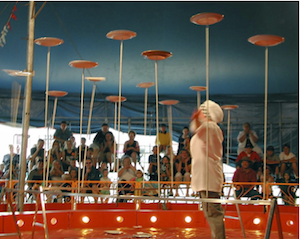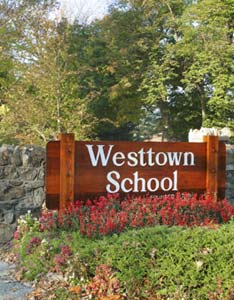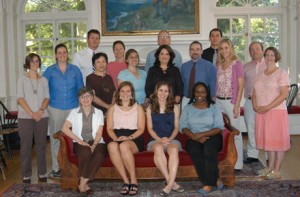 Our Head of School once described his job as one of keeping lots of plates spinning; his round of meetings hopefully touched a project just at the moment that it needed a bit more attention or energy. This metaphor speaks to me in my own work as Westtown School‘s Director of Teaching and Learning.
Our Head of School once described his job as one of keeping lots of plates spinning; his round of meetings hopefully touched a project just at the moment that it needed a bit more attention or energy. This metaphor speaks to me in my own work as Westtown School‘s Director of Teaching and Learning.
Unlike our HOS, I have fewer plates to juggle, and mine are clustered around the areas of curriculum and faculty learning. I inhabit a new position for the school. Previously, I was the school’s K-12 Curriculum Coordinator. I worked closely with our Assistant Head for Staff and Faculty Development. Last year as the school looked ahead to his retirement, we entered into discussions about removing redundancy and bringing program development and faculty development into closer alignment. The position of Director of Teaching and Learning grew out of those discussions.
As both an instructional leader and a teacher with World History students of my own, I am mindful of the many “21st century learning” advocates who hold up for us a world in which our students will work in jobs that have yet to be created and likely will hold numerous jobs over the course of their lives. I see this school year as one of living into that experience as I sort through what this new position I’ve accepted will look like and how it will shape the school’s mission and recently adopted Global Vision Statement. At Westtown, global education is defined as “Collaborative learning and ethical leadership in a connected world.”
Aligning our teaching & learning
A decade ago Westtown didn’t have anyone whose core responsibility was either professional development or curricular coordination and innovation. Ongoing education for teachers was a highly individual choice with little support or expectation for much beyond belonging to a professional organization and perhaps attending a conference. In-service days were massive affairs with speakers and breakout groups to look at “important” institutional level topics. Invariably, no matter how well designed they were, teachers, sometimes in whole divisions, felt the topic missed the mark.
 As Curriculum Coordinator since 2003, my vision and work was to connect peers within and across divisions to discuss content, skills, and program integration. Families expected seamless transitions as their children moved through the program. I firmly believed the way to do this was to engender frank and sometimes difficult discussions about individual and related subject areas and skills. Using data gathered from young alums and from our graduates, inviting outside experts to come and observe us in action, and creating opportunities for discussions and alliance-building, we have slowly crafted a program that does in fact operate as a single school.
As Curriculum Coordinator since 2003, my vision and work was to connect peers within and across divisions to discuss content, skills, and program integration. Families expected seamless transitions as their children moved through the program. I firmly believed the way to do this was to engender frank and sometimes difficult discussions about individual and related subject areas and skills. Using data gathered from young alums and from our graduates, inviting outside experts to come and observe us in action, and creating opportunities for discussions and alliance-building, we have slowly crafted a program that does in fact operate as a single school.
Any given year I am helping one or two program areas carefully examine their curriculum with an eye towards making improvements. Other program areas are in various stages of implementing those changes. This year I have Health, History and Religion under review. The Math teachers are in the second year of implementing a new program from PreK through 7th grade. The Upper School teachers are eagerly awaiting their first students from this new program. English teachers are working on better text selection and developing a cross-divisional public speaking curriculum. My work involves keeping track of where folks are in their change process, suggesting a conference, reminding someone of a recommendation they agreed to work towards, helping administrators remove blocks from implementation of ideas and shifts that benefit our students.
Fostering collaboration
To curricular work I have added “fostering adult growth.” Whereas before I was helping others cycle through different stages of program development, now I am cycling through the busy lives of my colleagues, checking in with them about the goals they have set for themselves. This very personal work could spin off into rampant, unproductive individualism and take us back to the days when every teacher was on her own island, alone in a room with her students.
My responsibility is to connect individuals, to help them seek out collaborators and mentors. With so many things for teachers to learn and for our students to learn, no one person could possibly do everything for all of us. Modeling the power of a Personal Learning Network and working with teachers to create their own PLN’s has become paramount.
Sometimes removing barriers to personal growth is thornier than fostering program development. Without a doubt, time constraints justify most resistance to engaging with ongoing learning. Removing time as a barrier requires creativity. Rethinking time is in itself a shift, and much of my effort this year has been working with the arbiters of time to rethink our faculty meeting.
Instead of announcements and student discussions – important as they are – faculty meeting is perfect for professional development. Our Lower School has used faculty meeting to do age specific role plays around our new Olweus anti-bullying campaign, and most recently, our faculty generated a list of technology tools they wanted to explore in small groups—a highly productive afternoon.
Designing your own PD
One of the most exciting ideas I have experimented with is a 90-minute block of time in our regular inservice, which I have dubbed “design your own time.” In the weeks leading up to the inservice, the faculty brainstorm ideas, gather like minded individuals, clear their ideas with their immediate supervisor, and I find space and other resources for them.
This past January we had teachers joining each other in the library to read and discuss articles, science teachers planned a division wide lab measuring the ozone layer across the 600-acre campus, a few Lower School teachers worked on developing grade level blogs. Middle and Upper School English teachers discussed how to improve on the strengths of our summer reading program. In all, half the faculty opted for this self-directed option over the other workshops offered. I will say that I redirected two individuals who wanted to use this time for class and lab space maintenance. Call me selfish, but I need to insist on creativity.
I realize that some of the examples above may not seem that earth-shaking, but for a faculty overly used to top-down planning, this is a shift. I have a colleague who likes to remind me that it is the cumulating small changes, deftly coordinated with a vision, that lead to the big changes we seek for education. Just as my World History students are learning to own their own learning, so too must our faculty. Learning must be as much as part of a teacher’s experience as it is for her students.
Margaret Haviland
Latest posts by Margaret Haviland (see all)
- Student Creativity: the Importance of License and Limits - April 24, 2013
- Our US History Student Film Festival - January 31, 2013
- How I Spent My Summer Vacation — Teaching US History in Six Weeks to 10 Students Around the World - October 2, 2012


